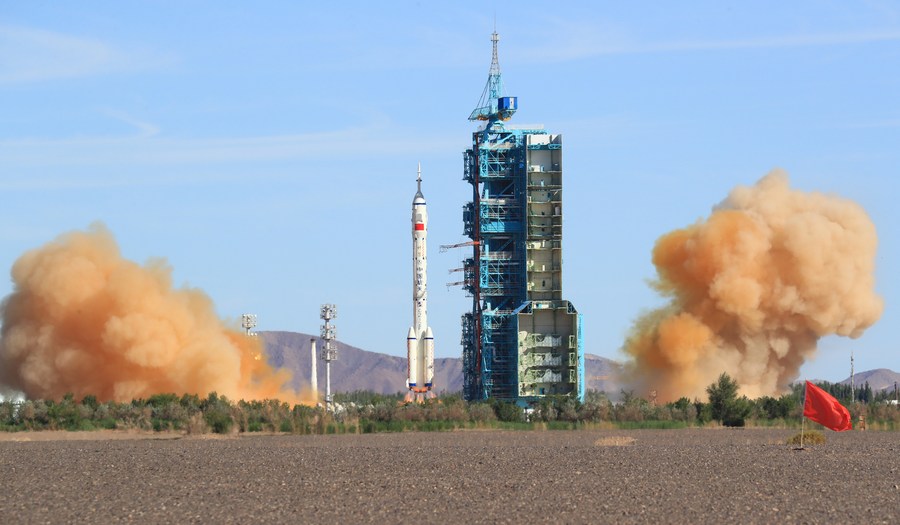
Screen image captured at Beijing Aerospace Control Center in Beijing, capital of China shows China's Shenzhou-12 manned spaceship having successfully docked with the space station core module Tianhe, June 17, 2021. /Xinhua
Screen image captured at Beijing Aerospace Control Center in Beijing, capital of China shows China's Shenzhou-12 manned spaceship having successfully docked with the space station core module Tianhe, June 17, 2021. /Xinhua
Editor's note: Prof. Bernard Foing is the Director of International Lunar Exploration Working Group (ILEWG) EuroMoonMars, the Chair of IAF ITACCUS committee, and the vice-chair COSPAR at the exploration panel and planetary commission. The article reflects the author's opinions and not necessarily the views of CGTN.
A few hours ago, Chinese astronauts, or taikonauts, Liu Boming and Tang Hongbo embarked on the first spacewalk of the Tianhe space station construction stage, the second spacewalk in China's history since Shenzhou-7 in 2008. For this extravehicular activity (EVA), they wear the new space suit and are installing equipment and the 10-meter robotic arm that will be used for moving space modules in the future. This is another remarkable achievement for China.
It shows the rapid development of China's space industry, including great programs for Earth observations, navigation and applications for people, ground installations, space robotic missions such as lunar Chang'e program, Tianwen/Zhurong Mars mission, and human space flight achievements.
On June 17, 2021, the Shenzhou-12 docked with the space station core module Tianhe within six hours of its launch. This historical event has been witnessed from the Global Space Exploration Conference (GLEX) in St. Petersburg with 700 space exploration experts, 20 astronauts, etc., who were impressed and in admiration for the Tianhe technology and human achievement.
With a size a quarter of International Space Station (ISS), and T-shaped configuration, Tianhe space station is remarkable for science, technical development and international collaboration. Additional modules, and scientific racks and engineering experiments will be sent later.
When the Chinese Space Station completes its initial construction goals as planned in 2022, it will complement the international space station that is about to be operating at least until 2025 and might evolve to include more commercial operations. There are future projects of smaller U.S., Russian and commercial stations, and it will be of interest to establish collaborations between Tianhe and other human stations and spacecraft in low-Earth orbit.
China is conducting bilateral cooperation and exchanges with France, Italy and other countries on Tianhe space station experiments in the fields of basic physics, space medicine and space astronomy. That is significant for strengthening cooperation on the space station, and to conduct new science research.
Since 2016, China has also carried out cooperation with the United Nations Office for Outer Space Affairs, inviting all UN member states to participate in cooperative experimental projects that are interested in carrying the Chinese space station.

The crewed spacecraft Shenzhou-12, atop a Long March-2F carrier rocket, is launched from the Jiuquan Satellite Launch Center in northwest China's Gobi Desert, June 17, 2021. /Xinhua
The crewed spacecraft Shenzhou-12, atop a Long March-2F carrier rocket, is launched from the Jiuquan Satellite Launch Center in northwest China's Gobi Desert, June 17, 2021. /Xinhua
Nine projects from 17 countries have been selected. This includes astrophysics, microgravity physics and biology, Earth observations and technology such as AsGa gallium arsenide semi-conductor and microphase cooling.
China is also considering a human mission to the moon after 2030, and has begun working on an international lunar research station (in orbit and surface) with partners such as Russia and European countries. This will build on previous efforts, as China developed the Chang'e lunar robotic exploration program and lunar automatic sample return. This will continue with future Chang'e missions.
Russia developed historical lunar missions with Lunokhod and three sample returns, and is developing new ones Luna 25 lander, Luna 26 orbiter, Luna 27 polar lander with European Space Agency contributions. Russia has great human spaceflight experience with their Soyuz rocket and capsules, the build-up of MIR station operated from 1986 to 2001, and key contributions to ISS station and operations. Europe launched SMART-1 first lunar mission of the millennium and collaborated with China, Russia and U.S. on lunar projects.
With China's technical and scientific advancement in human space flight and robotic, and partners from with Russia, Europe and the world, there will be opportunities to build a lunar surface research station, and in possible coordination with Artemis and other lunar exploration programs.
Testing with candidate astronauts some moonbase prototypes in Earth extreme analogues is already undergoing. There will be great opportunities for science, technology, resources, economy, peaceful cooperation, public inspiration, and space education for all.
For now, the start of Tianhe human operations and today's spacewalk are historical milestones that encourage positively our world towards a space renaissance beyond Earth.
(If you want to contribute and have specific expertise, please contact us at opinions@cgtn.com.)

